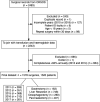Changes in perioperative red cell transfusion practice over time in patients undergoing surgery for upper gastrointestinal and liver cancer: a retrospective cohort study at a single tertiary centre
- PMID: 35534069
- PMCID: PMC9086641
- DOI: 10.1136/bmjopen-2021-054193
Changes in perioperative red cell transfusion practice over time in patients undergoing surgery for upper gastrointestinal and liver cancer: a retrospective cohort study at a single tertiary centre
Abstract
Objectives: Optimum transfusion trigger for adults undergoing cancer surgery is uncertain. Published guidelines recommend restrictive transfusion strategies in hospitalised adults. We aimed to measure the red cell transfusion rate and haemoglobin trigger in patients undergoing cancer surgery and how closely practice reflected published guidelines.
Design: Retrospective cohort study.
Setting: Single tertiary centre.
Participants: Adult patients undergoing surgery for upper gastrointestinal or liver malignancy.
Exposure: Postguideline change (2015-2017) versus preguideline change (2011-2012).
Outcome measures: Primary: transfusion rate, secondary: transfusion trigger. Multivariable logistic regression was used to assess factors and adjust for confounders affecting our outcome measures.
Results: 1578 surgical records were identified for 1520 patients. 946/1530 (62%) patients had preoperative anaemia. The transfusion rate decreased from 23% in 2011-2012 to 14% in 2015-2017. This change remained significant after adjusting for other variables associated with transfusion rates. Mean pretransfusion haemoglobin in those who were transfused was 78±13 g/L in 2011-2012 and 80±15 g/L in 2015-2017. This change in haemoglobin transfusion triggers was not significant.
Conclusion: Transfusion rate has decreased over the study period in patients undergoing surgery for malignancy and is consistent with a restrictive transfusion strategy.
Keywords: anaemia; cancer; health services research; surgery; transfusion.
© Author(s) (or their employer(s)) 2022. Re-use permitted under CC BY-NC. No commercial re-use. See rights and permissions. Published by BMJ.
Conflict of interest statement
Competing interests: None declared.
Figures


Similar articles
-
Influence of anaemia and red blood cell transfusion on mortality in high cardiac risk patients undergoing major non-cardiac surgery: a retrospective cohort study.Br J Anaesth. 2017 Jun 1;118(6):843-851. doi: 10.1093/bja/aex090. Br J Anaesth. 2017. PMID: 28481995
-
Impact of gender parity on preoperative anaemia prevalence and Patient Blood Management practice.Blood Transfus. 2021 Sep;19(5):396-402. doi: 10.2450/2020.0158-20. Epub 2020 Sep 17. Blood Transfus. 2021. PMID: 33196412 Free PMC article.
-
Liberal transfusion strategy to prevent mortality and anaemia-associated, ischaemic events in elderly non-cardiac surgical patients - the study design of the LIBERAL-Trial.Trials. 2019 Feb 4;20(1):101. doi: 10.1186/s13063-019-3200-3. Trials. 2019. PMID: 30717805 Free PMC article.
-
Restrictive Versus Liberal Strategy for Red Blood-Cell Transfusion: A Systematic Review and Meta-Analysis in Orthopaedic Patients.J Bone Joint Surg Am. 2018 Apr 18;100(8):686-695. doi: 10.2106/JBJS.17.00375. J Bone Joint Surg Am. 2018. PMID: 29664857
-
Red blood cell transfusion strategies.Transfus Clin Biol. 2001 Jun;8(3):207-10. doi: 10.1016/s1246-7820(01)00136-7. Transfus Clin Biol. 2001. PMID: 11499959 Review.
References
-
- World Health Organization . Haemoglobin concentrations for the diagnosis of anaemia and assessment of severity. World health organization 2011.
MeSH terms
Substances
LinkOut - more resources
Full Text Sources
Medical
